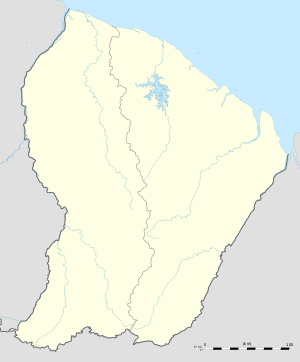Teko people
The Teko (also called Emerillon, Emerilon, Emerion, Mereo, Melejo, Mereyo, Teco)[2] are a Tupi–Guarani-speaking people in French Guiana living on the banks of the Camopi and Tampok rivers. Their subsistence is based on horticulture, hunting and various fishing techniques. As of 2010 they numbered about 410 individuals.[1]
Emerillon | |
|---|---|
| Total population | |
| 410[1] (2010, est.) | |
| Regions with significant populations | |
| Camopi, French Guiana | |
| Languages | |
| Emerillon, French | |
| Religion | |
| Traditional Amerindian | |
| Related ethnic groups | |
| Wayampí, Wayana |
History
The Teko constitute one of the six now-living ethnic groups of French Guiana already present before colonization. More nomadic than the other ethnic groups of the area, the Teko resided on different rivers in French Guiana during the colonial period, notably on the Approuague and, more recently, they settled within the surroundings of the Tampok and Maroni River near the border with Suriname, and the Camopi River near the border with Brazil.[3] Their villages, usually located at a distance from the rivers for protection from raids, were moved frequently due to soil exhaustion, warfare, and several customary reasons, like the death of a chief.
The Teko' first contact with the Europeans occurred in 1767 when an expedition lead by Patris, came across the tribe. The number of people was estimated at 350 to 400. They were in continuous warfare against the Galibi Amerindians who often raided their territory.[4] By the 19th century internal and intertribal warfare had weakened the Teko to the point of being collective slaves to the Wayampi. The tribal warfare ended after the French government had threatened a military intervention.[4] The fighting, along with the epidemics, greatly reduced their numbers. In 1849, Bagot estimated their numbers around 100 people.[5]
By the late 1960s, the Teko were in a poor state of health, however due to general health improvements and various demographic strategies, they have since grown to the number of approximately 400.[2] In the 1960s, the French Government contacted all tribes to ask them whether they wanted French citizenship. The Wayampi, who did accept citizenship in 2000,[6] and the Teko were the only tribes who decided against citizenship.[7] During the same period, the French government tried to the concentrate the population in larger villages with limited success.[1] The government installed male captains, based on the Maroon hierarchy, to head the villages,[1] however being a matrilocality, the position was often inherited by the widow.[8] In 2012, the Teko resisted the creation of the Guiana Amazonian Park as a restriction to their free movement.[9]
Lifestyle
The Teko practice slash-and-burn agriculture and compliment the food supply with hunting, gathering and fishing. Many of the villagers live in wooden huts with palm leaves, however concrete houses are becoming more common.[10]
The tribe is matrilocal, i.e. the husband moves into the wife's village. In the 1960s polygamy was still being practised, but in decline. Marriages with other tribes and ethnic groups was on the rise.[11]
Language
Emerillon is the eponymous term for their language which belongs to the Tupí-Guaraní family.[12] An identifying characteristic of the language is nasal harmony.[13] The language is still being passed on to the children as the native language, however French, Portuguese and Wayampí are becoming secondary languages.[2] The effect is mainly limited to borrowing of the lexicon of the European languages, however the language is considered endangered.[12]
Villages
The Teko are in a minority in the following Wayana villages:
The Teko are in a minority in the following Wayampi villages:
References
- Daby & Tritsch 2012, p. 9.
- Rose 2008, p. 431.
- Møhl 2012, p. 17.
- Hurault 1963, p. 134.
- Hurault 1963, p. 135.
- "ACCES AUX DROITS DES POPULATIONS AUTOCHTONES AMERINDIENNES DE GUYANE HAUT MARONI". LDH Paris (in French). Retrieved 31 July 2020.
- "Considérations sur la situation des Amérindiens de l'intérieur de la Guyane page 223". Persée (in French). 1990. Retrieved 2 June 2020.
- Daby & Tritsch 2012, p. 17.
- Daby & Tritsch 2012, p. 19.
- "Environmental, entomological, socioeconomic and behavioural risk factors for malaria attacks in Amerindian children of Camopi, French Guiana". US National Library of Medicine. Retrieved 1 August 2020.
- Hurault 1963, p. 139.
- Rose 2008, p. 432.
- Rose 2008, p. 437.
- "Teko - Populations de Guyane". Populations de Guyane (in French). Retrieved 1 August 2020.
- Thomas Malmontet (2020). "Spectrum of skin diseases in Amerindian villages of the Upper Oyapock, French Guiana". Wiley Publishers: 600. Retrieved 1 August 2020.
Bibliography
- Daby, Damien; Tritsch, Isabelle (2012). "Construction et restructuration territoriale chez les Wayãpi et Teko de la commune de Camopi, Guyane française". Research Gate (in French).
- Rose, Françoise (2008). "A typological overview of Emerillon, a Tupi-Guarani language from French Guiana". HAL.CS1 maint: ref=harv (link)
- Hurault, Jean (1963). "Les Indiens Émerillon de la Guyane française". Persee. Journal de la société des américanistes (in French).CS1 maint: ref=harv (link)
- Møhl, Perle (2012). Omens and Effect: Divergent Perspectives on Emerillon Time, Space and Existence. Research Gate. Semeion Editions. ISBN 979-10-90448-02-5.CS1 maint: ref=harv (link)
- Wilbert, Johannes; Levinson, David (1994). Encyclopedia of World Cultures. Volume 7: South America. Boston: G. K. Hall. ISBN 0-8161-1813-2
